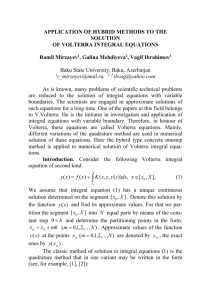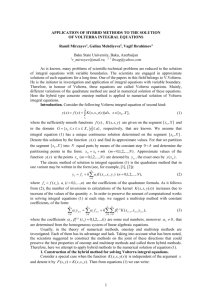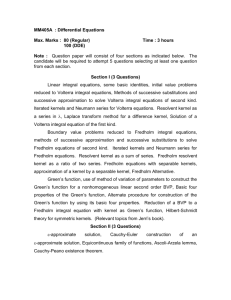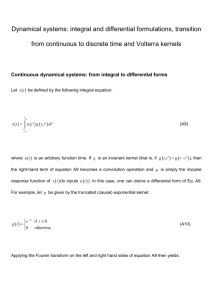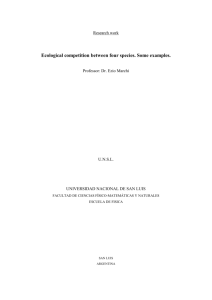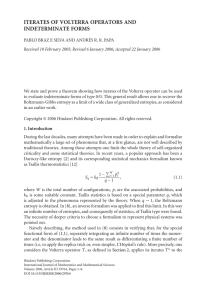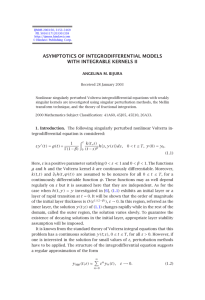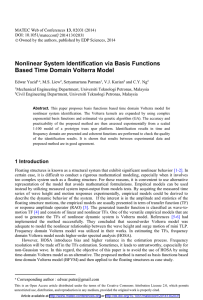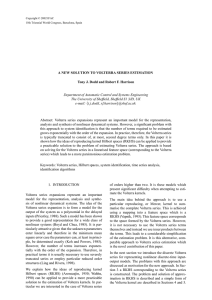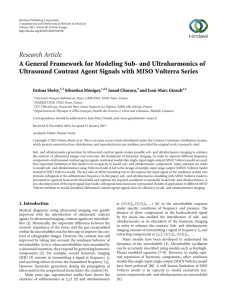A Simple Introduction to Integral Equations
advertisement
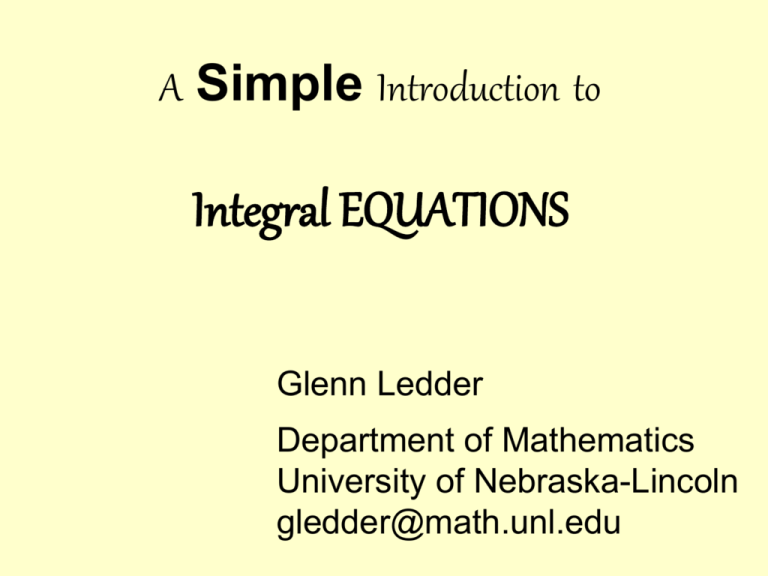
A Simple Introduction to Integral EQUATIONS Glenn Ledder Department of Mathematics University of Nebraska-Lincoln gledder@math.unl.edu Some Integral Equation Examples 2s y ( s) y (t ) ds 0 1 y( s) Volterra second kind t 2 t s y( s) ds Volterra second kind t 2 t s y( s) ds Fredholm second kind t y (t ) y (t ) t 0 t 0 1 0 y ( s ) ds t s 2 2 t Volterra first kind Integral Equations from Differential Equations First-Order Initial Value Problem y '(t ) F (t ) g (t , y (t )), y (t ) y 0 Volterra Integral Equation Of the Second Kind y (a ) y 0 F (s) ds g(s, y(s)) ds t t a a Used to prove theorems about differential equations. Used to derive numerical methods for differential equations. • Volterra IEs of the second kind (VESKs) • Symbolic solution of separable VESKs • Volterra sequences and iterative solutions • Theory of linear VESKs • Brief mention of Fredholm IEs of 2nd kind • An age-structured population model Volterra Integral Equations of the Second Kind (VESKs) Given g : R3→R and f: R→R , find y: R→R such that y(t ) f (t ) g(t , s, y( s)) ds t a [equivalent to an initial value problem if g is independent of t] y (t ) y 0 F (s) ds g(s, y(s)) ds t t a a Volterra Integral Equations of the Second Kind (VESKs) Given g : R3→R and f: R→R , find y: R→R such that y(t ) f (t ) g(t , s, y( s)) ds t a Linear: y (t ) f (t ) k (t , s) y(s) ds t a Separable: k (t , s) p(t ) q ( s) Convolved: k (t , s) r (t s) Symbolic Solution of Separable VESKs Solve Let y (t ) Y (t ) t t 0 2 t s y( s) ds t 0 sy( s) ds Then y (t ) t 2 t Y (t ) New Problem: Y '(t ) Solution: t y t 2t Y ( t ) , y (t ) te t 2 Y (0) 0 y(t ) 1 (t s) y( s) ds t Solve Let Y (t ) 0 t 0 y( s) ds and Z (t ) sy(s) ds t 0 New Problem: Y Y 0 , Y (0) 0, Y (0) 1, Z Y tY 1 Solution: y(t ) cos t Volterra Sequences Given f, g, and y0, define y1, y2, … by y1 (t ) f (t ) t y 2 (t ) f ( t ) t and so on. a a g(t , s, y0 ( s)) ds g(t , s, y1 ( s)) ds Volterra Sequences Given f, g, and y0, define y1, y2, … by y n (t ) f (t ) t a g(t , s, yn1 ( s)) ds , n 1, 2, •Does yn converge to some y ? •If so, does y solve the VESK? Volterra Sequences Given f, g, and y0, define y1, y2, … by y n (t ) f (t ) t a g(t , s, yn1 ( s)) ds , n 1, 2, •Does yn converge to some y ? •If so, does y solve the VESK? •If so, is this a useful iterative method? A Linear Example y(t ) 1 (t s) y( s) ds t 0 Let y0 = 1. Then y1 (t ) 1 (t s) ds 1 21 t 2 t 0 y 2 (t ) 1 t 0 (t s)(1 s ) ds 1 t 2 1 2 1 2 2 1 24 t 4 ↓↓ y 1 t 1 2 2 1 24 t 4 1 6! t cos t 6 The sequence converges to the known solution. Convergence of the Sequence y0 y1 y2 y3 y4 y5 y6 y A Nonlinear Example 2 s y ( s) y (t ) ds 0 1 y ( s) t Let y0 = 0. Then y1 (t ) 2sds t t 2 0 2s s 3 1 y2 (t ) ds t ln(1 t ) ln(1 t ) 2 2 2 0 1 s 2 t ln(1 s) 3 ln(1 s) 2s y 3 (t ) ds 0 ln(1 s) 3 ln(1 s) 2 s 2 t Convergence of the Sequence y3 y2 y1 Lemma 1 Homogeneous linear Volterra sequences k (t , s) y t y n (t ) a n 1 ( s) ds , n 1, 2, decay to 0 on [a, T] whenever k is bounded. Proof: (a=0) Choose constants K, Y and T such that | k (t , s)| K , | y0 (t )| Y , 0 t , s T Then | y1 (t )| t 0 k (t , s) y0 ( s) ds KY ds YKt t 0 Given | k (t , s)| K , | y0 (t )| Y , 0 t , s T y n (t ) we have k (t , s) y t 0 | y1 (t )| n 1 ( s) ds , n 1, 2, KY ds YKt t 0 1 | y2 (t )| K (YKs) ds YK 2 t 2 0 2 t 1 3 3 | y3 (t )| K ( YK s ) ds YK t 0 3! t In general, 1 n n | yn (t )| YK t n n! 2 2 1 2 so lim yn 0 n Theorem 2 Homogeneous linear VESKs y (t ) k (t , s) y(s) ds t a have the unique solution y ≡ 0. Proof: Let φ be a solution. Choose y0 = φ. Then yn = φ for all n, so yn→φ. But the lemma requires yn→0. Therefore φ ≡ 0. Theorem 3 Linear VESKs have at most one solution. Proof: Suppose (t ) f (t ) ak (t , s) ( s) ds and (t ) f (t ) ak (t , s) ( s) ds t t Let y = φ – ψ. Then y (t ) k (t , s) y(s) ds t a By Theorem 2, y ≡ 0; hence, φ = ψ. Lemma 4 Linear Volterra sequences with y0=f converge. Sketch of Proof: Define yn (t ) f (t ) gn k (t , s) y t a |y m 1 n m n 1 ( s) ds , y0 f y n m 1 | 1) gn → 0 2) | yn m yn | gn Together, these properties prove the Lemma. Theorem 5 Linear VESKs have a unique solution. Proof: By Lemma 4, the sequence yn (t ) f (t ) k (t , s) yn1 ( s) ds , y0 f t a converges to some y. Taking a limit as n → ∞: y(t ) f (t ) k (t , s) y( s) ds t a The solution is unique by Theorem 3. Fredholm Integral Equations of the Second Kind (linear) Given g : R3→R and f: R→R , find y: R→R such that y(t ) f (t ) k (t , s) y( s) ds b a • Separable FESKs can be solved symbolically. • Fredholm sequences converge (more slowly than Volterra sequences) only if ||k|| is small enough. • The theorems hold if and only if ||k|| is small enough. An Age-Structured Population Given An initial population of known age distribution Age-dependent birthrate Age-dependent death rate Find Total birthrate Total population Age distribution An Age-Structured Population Simplified Version Given An initial population of newborns Age-dependent birthrate Age-independent death rate Find Total birthrate Total population The Founding Mothers Assume a one-sex population. Starting population is 1 unit. Life expectancy is 1 time unit. p0′ = -p0, p0(0) = 1 Result: p0(t) = e-t Basic Birthrate Facts Total Birthrate = Births to Founding Mothers + Births to Native Daughters b(t) = m(t) + d(t) Let f (t) be the number of births per mother of age t per unit time. m(t) = f (t) e-t Births to Native Daughters Consider daughters of ages x to x+dx. All were born between t-x-dx and t-x. The initial number was b(t-x)dx. The number at time t is b(t-x)e-x dx. The rate of births is f(x)b(t-x)e-x dx =m(x)b(t-x)dx. d (t ) m( x) b(t x) dx t 0 The Renewal Equation b(t ) m(t ) m( x) b(t x) dx t 0 or b(t ) m(t ) m(t x) b( x) dx t 0 This is a linear VESK with convolved kernel. It can be solved by Laplace transform. Solution of the Renewal Equation Given the fecundity function f, define F ( s) F ( s) L f (t ), r (t ) L 1 F ( s) 1 where L is the Laplace transform. Then t b(t ) e r (t ) t p(t ) e e t r( x) dx t 0 A Specific Example Let f(x) = a xe -2x. Then b(t ) p(t ) a 2 e ( a 3) t a ( a 3) t 2( a 2) e 4 t a4 If a=9, then p(t) →1.5. Exponential growth for a>9. The population dies if a<9. a 2 e e ( a 3) t a ( a 3) t 2( a _ 2) e Fecundity a = 10 a=9 a=8 Birth Rate a = 10 a=9 a=8 Population a = 10 a=9 a=8
